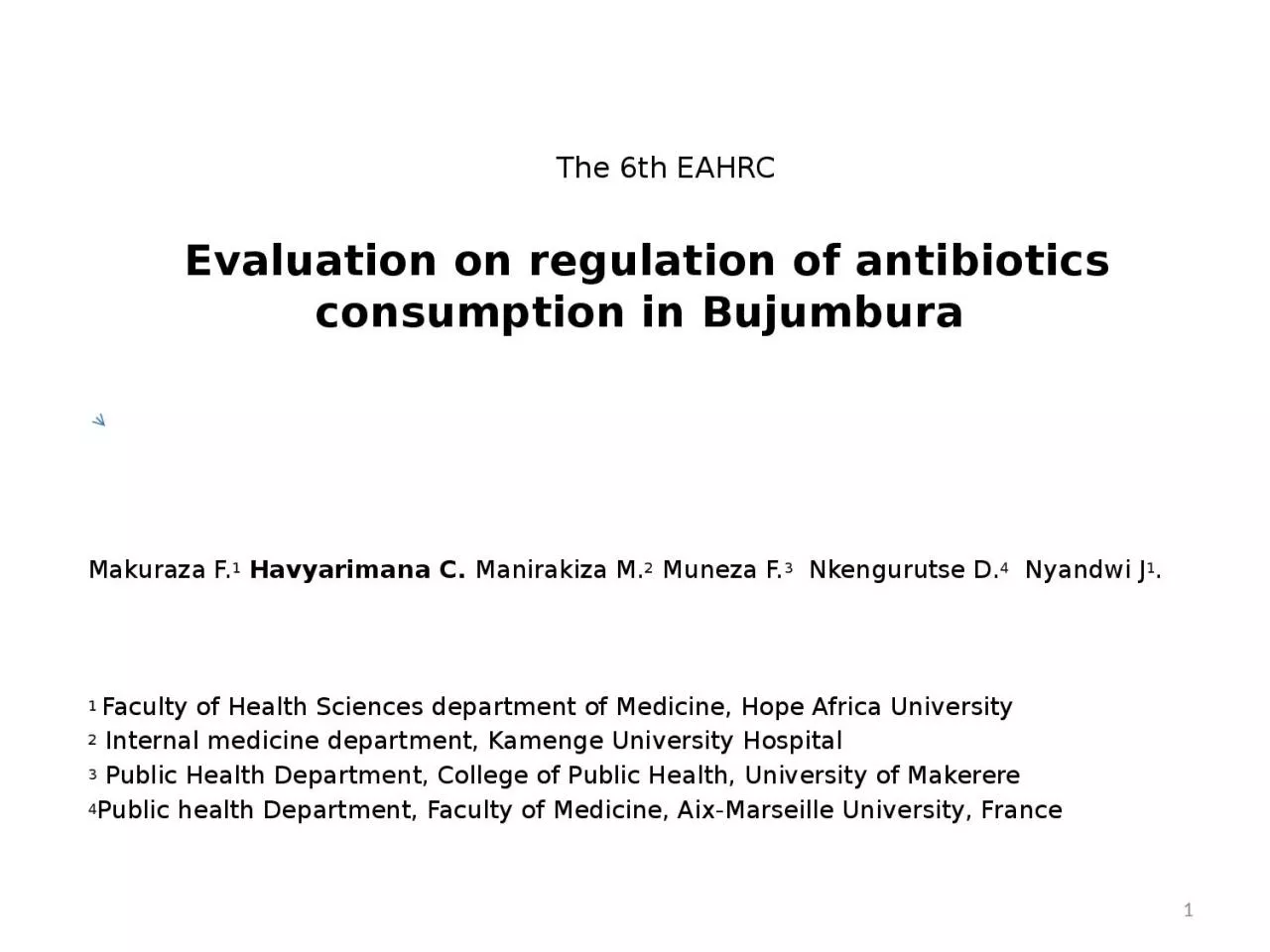

Bujumbura Makuraza F 1 Havyarimana C Manirakiza M 2 Muneza F 3 Nkengurutse D 4 Nyandwi J 1 1 Faculty of Health Sciences department of Medicine Hope Africa University ID: 1036403
Download Presentation The PPT/PDF document "The 6th EAHRC Evaluation on regulati..." is the property of its rightful owner. Permission is granted to download and print the materials on this web site for personal, non-commercial use only, and to display it on your personal computer provided you do not modify the materials and that you retain all copyright notices contained in the materials. By downloading content from our website, you accept the terms of this agreement.
1. The 6th EAHRC Evaluation on regulation of antibiotics consumption in BujumburaMakuraza F.1 Havyarimana C. Manirakiza M.2 Muneza F.3 Nkengurutse D.4 Nyandwi J1.1 Faculty of Health Sciences department of Medicine, Hope Africa University 2 Internal medicine department, Kamenge University Hospital3 Public Health Department, College of Public Health, University of Makerere4Public health Department, Faculty of Medicine, Aix-Marseille University, France1
2. INTRODUCTIONAntibiotics are medicines used to prevent and treat bacterial infections. Antibiotic resistance is a phenomenon that occurs naturally, but misuse of antibiotics in humans and animals is accelerating the process. Bacteria become antibiotic-resistant. These bacteria may infect humans and animals, and infections they cause are harder to treat than those caused by non-resistant bacteria.Antibiotic resistance leads to higher medical costs, prolonged hospital stays, and increased mortality.Actually, tackling antibiotic resistance is a high priority for WHOWe addressed one of the factors influencing it and we did it in pharmacies where we met pharmacists who are the first ones to receive clients who practice self-medication with antibiotics and clients doing this practice 2
3. MATERIAL AND METHODSStudy areaUrban area of BujumburaStudy design Cross sectionnal studyStudy population Clients who visited the 26 private and 6 public pharmacies of the urban area of Bujumbura from January 2015 and September 2015Sellers of pharmacies we visitedSamplingSystematic random samplingEach 4th or 5th client was asked to complete the questionnaireOne seller per pharmacy was also given a specific questionnaire to completeWe alternated visits of those pharmacies after 15 days 3
4. Data collection tools and proceduresClients were asked to answer an anonymous questionnaire regarding their use of medicines in the eight months preceding the present illness. Those who had practiced self-medication with antibiotics where asked questions about how they took those medicines, what medicines they used, the reasons that motivated them to choose the antibiotics presented,Sellers were asked about their knowledge about self-medication with antibiotics but also about how is organized selling antibiotics in pharmacies they were working for.Survey toolQuestionnaire Data analysis Analyzation with Epi info 3.5.3 using mean and standard deviation for continuous variables, frequencies and proportions for categorical variables. 4
5. RESULTSGraph 1: Symptoms leading to self-medication with antibiotics5
6. Graph 2: Commonly used antibiotics in self-medication 6
7. N=192%Lack of financial resources enabling access to health care10856,25Consideration of the last prescription of the physician for the same symptoms5227,08Avoiding queues in public health services2513,02Ignorance of the importance of visiting physicians63,12Self assessment of an emergency situation21,04Trusting the pharmacist10,52Total192100 Table 1: Reasons to self-medication with antibiotics7
8. In 84,4% of the cases, self-medicated antibiotics were from community pharmacies. 61.82% of our participants who practice self-medication to antibiotics normally pay the total amount of the fees without or not prescription,93,7 % of the sellers interviewed responded they often ask a written prescription from those willing to buy antibiotics. Only one person always asked for the prescription. 82% of the sellers declared they sell always non prescribed antibiotics whenever they receive prescription or not from the clients. Actually in Burundi, there is not yet policy and control services that are efficient reducing the phenomenon. As an example, there is no policy against commercialization of antibiotics without prescriptions in Burundi.8
9. DISCUSSIONFrequencies are generally high in countries where similar studies were done (Lithuania (39,9%), Sudan (48%), Nairobi (53.5%), Abu Dhabi (56%) , Bujumbura (46%)) . Symptoms like cough, throat pain, thoracic pain related to pathologies of the respiratory airways motivate most self-medication to antibiotics. In our study, cough is in the second position after abdominal pain in the symptoms motivating self-medication. The omnipresence of the molecule of amoxicillin in our study but also in other similar studies can be explained by the fact the group of beta lactamines is most of the time used for pathologies of the respiratory pathway in outpatients consultation , and consequently they are the most known of the public. 9
10. CONCLUSIONAntibiotic resistance is accelerated by the misuse and overuse of antibiotics, as well as poor infection prevention and control and frequencies are very high.Steps can be taken at all levels of society to reduce the impact and limit the spread of resistance especially for policy makers who should:Ensure a robust national action plan to tackle antibiotic resistance is in place.Improve surveillance of antibiotic-resistant infections.Strengthen policies, programs, and implementation of infection prevention and control measures.Regulate and promote the appropriate use and disposal of quality medicines.Make information available on the impact of antibiotic resistance.10
11. AcknowledgementThank you for your attention11